As told to Amanda Oliver, 2818 words.
Tags: Art, Inspiration, Production, Process, Beginnings.
On doing what makes you feel good
Visual artist Bunnie Reiss discusses making public art, having no concrete language for the creative process, learning from older artists, and the concept of bug soup.In looking at your murals, they seem to represent the rhythm of a place and the places where you paint. They are always in conversation with a larger community. Can you speak more to what that process is like for you?
I think in being an artist, there’s a lot of stubbornness around it and you have to know that if you’re going to do something in public, you want to work with your community and that the vibrations are real. You’re going to be interacting with people all day long. So generally I look at what affects me when I go to places and it’s usually the nature. It’s the animals, it’s the flowers, it’s the things that represent the state, the city, and then I look at the architecture and I work with the architecture of the building, in conjunction with whatever large imagery I’ve decided to use. And then I work with the people who speak to me all day long.
And I’ll tell you, it is all day long. I will be on a lift with my headphones blasting, and I will hear somebody down below screaming. What are you doing up there, are you painting, are you painting a mural? All day long, you get down from the end of the day, there’s 30 people waiting to talk to you. They want selfies, they want to talk to you. And you’re already affecting so many things around you and all of these people are affecting you. It becomes a conversation as you’re moving on the wall. And it’s such a wonderful relationship.
Hamsa Wall. Detroit, Michigan. No Photo Credit.
I think that I’ll never not be able to do public art because the conversations I’ve had with just Americans, with just people living in our country, that are not anything like me at all. I have no idea what kind of suffering they’re going through. I have no idea what their day is like, but I do know that when they walked by, they felt good enough to stop and talk. And so I am always very available for that, even if I’m tired. And I think all of those relationships affect when you’re putting something on a wall, or you’re building an installation or you’re doing any of that.
How or when did you realize you were an artist?
Well, I was always a little weirdo kid for sure. And I was always expressing in different ways. I think you don’t really notice when you’re little, you’re just doing your thing. You’re like a little beast. And then as you get older, they beat the beast out of you. But that wild part of me stayed with me, thank goodness. I was always very creative. I was always drawing and painting and just expressing. I was just so different from a lot of other kids. And unfortunately that wasn’t really looked at as a bonus. I was well behaved until I became a teenager. I didn’t really understand that my thought process was just a creative problem solving process, versus a traditional way of thinking. And so it was hard being in public schools in that way, but I just always loved expression in any way that I could. I was always daydreaming and thinking about things and creating weird stories in my head, just super weird, unusual things. And my mother never tried to stop me. She was just like, “You’re just different. You’re special, and you’re different.” She’s always said that. She will always remind me even as an adult, she’s like, “Remember I used to always tell you were different, you were special, you were a special kid.”
So you always knew.
I always knew that I was going to do something that was going to be bigger than myself. And I don’t know when I really understood that, but I think that the art of making is a courageous act of going into an abyss, and that abyss is so much bigger than anything that you could possibly imagine. And when you’re a child, you’re still acting out like a beast. So you just live in that world. And I think as artists, we’re always like, trying to get back there. We’re like, how do I get back there? How do I just let everything around me fall away and get back into that state?
Do you have ways that you get back into that state?
I’ve always been really fascinated by the etymology of the word artist, which is genius. There was a Ted Talk I watched years ago. I can’t remember the woman’s name, honestly, but she talked about how pre-Renaissance, the artist was a spirit and it would go inside you and then you would create. So it wasn’t you as a human, it was you as a channeling device. And then post-Renaissance, when people stopped believing in the church and stopped believing in the spirit, the artist became a human. I think that’s where artists really struggle. For me, I’m just not in my body when I’m creating. And whether you call it a flow state or you call it whatever people call it, I feel like I’m just channeling something that’s bigger than me. I’m just grateful that they’ve chosen my body to do it in. And I never take for granted that it could go away at any moment, but I definitely know when I’m pushing up against it. And when I’m in the state where I can create.
There are times when it’s really hard. I don’t have a discipline where I’m working from eight to five. I’ve never been that kind of artist, but I do have an extreme discipline. It just doesn’t look like other people’s disciplines. It’s more doing what I want when I want to do it. And that’s where I think it gets tricky because if you’re going to be a career artist, you really have to figure out how to navigate through those ups and downs. And a lot of it is just staying calm, and knowing that you’re here, you’re here for a minute, you’re here in this weird meat bag. Just enjoy it, just enjoy it. And you know when you’re doing what you’re supposed to be doing.
Buffalo. Buffalo, NY. Photo Credit: Albright-Knox Art Gallery
Do you think you have always been able to feel that? It sounds almost somatic or intrinsic? Or do you think that developed over the years?
I think I didn’t have the words for it. And I’m sure that most artists would agree with that. We just don’t have a lot of language to talk about creative process. There’s key bullet points that always come up about it. But, in general, we don’t really look at why we do what we do. And I don’t think a lot of people do in the world, whatever they do, they don’t think about why they do it. A lot of people are part of like, nepotism—it’s a family thing or they went to school to get a job so that they could make money, so that they could have a family. There are narratives that are pretty consistent with most people. And I think with an artist, there’s no narrative. You can spend your whole life not making anything. And then one day, everything comes out. And I think that developing a language around why you do what you do can be dangerous. And so it’s better to just try to relax and do things that make you feel good.
I feel like especially with social media, some young creative people think that something happens overnight, but there’s usually this very long winding path. Do you ever feel like you’ve “made it”? Was there a moment where you felt like, “Oh, I’ve made it as an artist?”
I’ve never felt like I’ve made it. It wasn’t until about a decade ago that I started making a full-time living on my art. But I did everything I could to continue making my art and I never took creative positions or anything, any kind of production work, for fear that it would drain my creativity. So I did a lot of weird shit. I did a lot of weird stuff, anything I could do to just get money to continue working. And so that’s where I know my discipline is there. It’s just different.
But I think that there’s this misconception that it’s just easier than people think. It is constant work and you’re sacrificing a lot, and you’re going to work the hardest you’ve ever worked, and then you’re going to work even harder than that. And it doesn’t get easier. I mean, there are days where my body’s in so much pain from lifting too many things or doing too many things and I have to constantly consider what I’m putting in my system, what I’m eating. If I’m drinking, like how that’s going to affect me, because as I’m getting older, I can see that I still want to maintain that marathon feeling, but age is real, and we have a long career. And so I am very, very strict about all of that stuff in my life. And I don’t really poo-poo the internet. I use it and it works really well for me and I love it. But I do think that there’s a missing component of joy, of learning from other artists. And if we’re not moved by joy in this world, what are we moved by? Joy is really the core of life. And so when you work with people who are older than you, you really see someone who has spent their entire existence living in that state.
 Fox. El Segundo, California. Photo Credit: El Segundo Art Walk
Fox. El Segundo, California. Photo Credit: El Segundo Art Walk
I’ve gotten to work with a lot of artists. I had a mentor for a couple years in San Francisco who was an oil painter. She really helped me get into graduate school and throughout graduate school my director was incredible to me. I have other mentors that I felt very lucky to have taught me so much about public art, raising money for public art, and all of these people are quite a bit older than me. I am a very good listener. I listen to everything they tell me and I do everything that they say. I think that apprenticeship and finding other artists that are willing to take you under, or hire you, or anything is crucial in development. And it’s slow. I always say like, take your time with it because it just goes by so fast. Now, I go to these streets, it’s so fast, the way I’m painting, I’m in, I’m out. But it’s all process. There’s a lot of process ahead of time. There’s a lot of development and then there’s the actual execution. and I still have hiccups. I still am just like, “Oh, I didn’t think about that.” That still happens to me.
What do you do in those moments?
I just laugh, to be honest with you. I laugh it off, because it just reminds me that even though I’ve been doing it for so long, I’m still so new to it. And I hope I feel that way forever. I hope I feel like I’m never a master or I’m a master after I’m dead, because I want to just keep creating in a space that makes me feel like I’m learning things.
There are days, not often, especially because I live outside of cities now [where I think I feel like I’ve made it as an artist]. Life is just calmer now, but there are days that I don’t feel like I’m doing enough, and there are still lots of projects that I wish I could get and I’m not there yet. So I think that hunger and that learning is always there. It’s always there.
I imagine it is a really important piece of the creative process for you to continue to have that hunger for a lifetime?
Absolutely. And I also think it’s okay to take time off. It’s okay to step away from your practice and get information in the world in other ways.
And are there times that you have done that?
Very rarely, but I was forced to during the pandemic. And it was incredibly uncomfortable, but then it ended up being so fruitful on the other end of it. It really changed the core of my practice, but it was really hard. It was really hard to stop.
It was during the pandemic that you left Los Angeles and you moved full-time to Landers [California]. How has the change from city to desert impacted your work?
I could just tell that my time in cities is over for now. I love to visit them. I think they’re just full of so much wonder, but there’s so much trauma and PTSD and processing from all of us that were in cities during the pandemic and what we witnessed and what we saw and what we felt from our neighbors was pretty horrific. It was hard and you could just feel… it was like a pressure cooker. I think it just changed me to the core, like it did a lot of people. I’ve always been an activist, so I’ve always been hyper-aware of my position in the world and where I live in that position, but I’ve never ever thought that we would witness such a class war through a virus. And I think in cities it was so blatant, and so difficult to see, that I’m okay not living in places like that for a little while. And I was able to come out here [to Landers] and develop this property, which I’d always wanted to. I just didn’t think it would happen so soon. It was like a long term and those of us who bought years ago were really lucky because we bought for cash because they were cheap.
I don’t think any of us thought that we would come out here and we did. And now there’s this amazing community out here. There’s a real Renaissance going on. And I was able to do things that I had always thought about that not only informed my art, but informed my life, I grow food here, I developed a greywater system. I have livestock. These are things that I always wanted.I just didn’t think they would happen so soon. And all of that informs my process of making. So it’s just a different version of myself, but one that feels really right now.
Truck. Landers, California. No Photo Credit.
You seem very open to it. That if there was another evolution then you will move …
There will be, I mean, we inevitably are changing at the speed of light, we are changing and our access is moving. We are moving, so we will be changing like crazy. Do you know what bug soup is?
I don’t.
So, this is crazy. When a butterfly gets inside a cocoon, it completely dematerializes, it has no form. It’s goo, and a scientific name for it is bug soup. Then it rematerializes into its next form. As a caterpillar, it goes in, it dissolves, it rematerializes and comes out new. As people, we also have this opportunity to always lean into whoever we’re going to be. It takes so much courage and it’s really hard. We’re in a complicated world. It’s not going to get any easier. This is our world now and it will shift again. And it will probably be worse. But out of that also comes a lot of beauty. And so we have to be vulnerable enough and courageous enough to accept those things as they come into our lives. And my hope is that people really begin to understand that. And I see that shift happening. I see it happening with people. They’re confused and they’re uncomfortable and they’re depressed. And I’m like, “That is it right now. You are in bug soup right now, that’s it.” So I know that where I am right now in my world is temporary. And it will change. It’ll change next month. It’ll change next year. But it feels so good that I’m okay with it. And I will ride the wave until I need to adjust it.
Bunnie Reiss Recommends:
The Golden Compass Book Series
Niagara Falls
stinging nettle
desert sunrise







